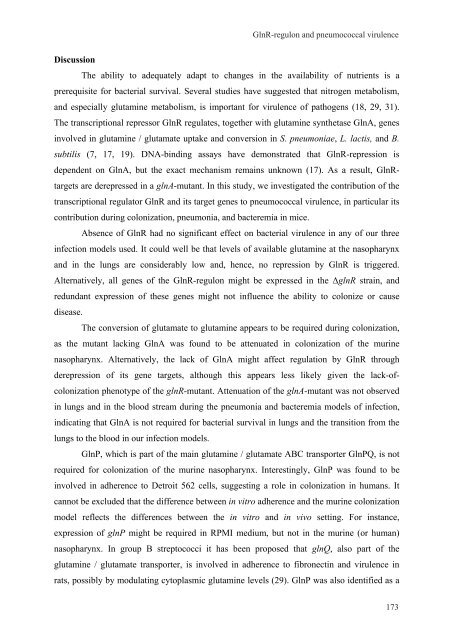Gene regulation in Streptococcus pneumoniae - RePub - Erasmus ...
Gene regulation in Streptococcus pneumoniae - RePub - Erasmus ...
Gene regulation in Streptococcus pneumoniae - RePub - Erasmus ...
Create successful ePaper yourself
Turn your PDF publications into a flip-book with our unique Google optimized e-Paper software.
Discussion<br />
The ability to adequately adapt to changes <strong>in</strong> the availability of nutrients is a<br />
prerequisite for bacterial survival. Several studies have suggested that nitrogen metabolism,<br />
and especially glutam<strong>in</strong>e metabolism, is important for virulence of pathogens (18, 29, 31).<br />
The transcriptional repressor GlnR regulates, together with glutam<strong>in</strong>e synthetase GlnA, genes<br />
<strong>in</strong>volved <strong>in</strong> glutam<strong>in</strong>e / glutamate uptake and conversion <strong>in</strong> S. <strong>pneumoniae</strong>, L. lactis, and B.<br />
subtilis (7, 17, 19). DNA-b<strong>in</strong>d<strong>in</strong>g assays have demonstrated that GlnR-repression is<br />
dependent on GlnA, but the exact mechanism rema<strong>in</strong>s unknown (17). As a result, GlnR-<br />
targets are derepressed <strong>in</strong> a glnA-mutant. In this study, we <strong>in</strong>vestigated the contribution of the<br />
transcriptional regulator GlnR and its target genes to pneumococcal virulence, <strong>in</strong> particular its<br />
contribution dur<strong>in</strong>g colonization, pneumonia, and bacteremia <strong>in</strong> mice.<br />
Absence of GlnR had no significant effect on bacterial virulence <strong>in</strong> any of our three<br />
<strong>in</strong>fection models used. It could well be that levels of available glutam<strong>in</strong>e at the nasopharynx<br />
and <strong>in</strong> the lungs are considerably low and, hence, no repression by GlnR is triggered.<br />
Alternatively, all genes of the GlnR-regulon might be expressed <strong>in</strong> the ΔglnR stra<strong>in</strong>, and<br />
redundant expression of these genes might not <strong>in</strong>fluence the ability to colonize or cause<br />
disease.<br />
The conversion of glutamate to glutam<strong>in</strong>e appears to be required dur<strong>in</strong>g colonization,<br />
as the mutant lack<strong>in</strong>g GlnA was found to be attenuated <strong>in</strong> colonization of the mur<strong>in</strong>e<br />
nasopharynx. Alternatively, the lack of GlnA might affect <strong>regulation</strong> by GlnR through<br />
derepression of its gene targets, although this appears less likely given the lack-of-<br />
colonization phenotype of the glnR-mutant. Attenuation of the glnA-mutant was not observed<br />
<strong>in</strong> lungs and <strong>in</strong> the blood stream dur<strong>in</strong>g the pneumonia and bacteremia models of <strong>in</strong>fection,<br />
<strong>in</strong>dicat<strong>in</strong>g that GlnA is not required for bacterial survival <strong>in</strong> lungs and the transition from the<br />
lungs to the blood <strong>in</strong> our <strong>in</strong>fection models.<br />
GlnR-regulon and pneumococcal virulence<br />
GlnP, which is part of the ma<strong>in</strong> glutam<strong>in</strong>e / glutamate ABC transporter GlnPQ, is not<br />
required for colonization of the mur<strong>in</strong>e nasopharynx. Interest<strong>in</strong>gly, GlnP was found to be<br />
<strong>in</strong>volved <strong>in</strong> adherence to Detroit 562 cells, suggest<strong>in</strong>g a role <strong>in</strong> colonization <strong>in</strong> humans. It<br />
cannot be excluded that the difference between <strong>in</strong> vitro adherence and the mur<strong>in</strong>e colonization<br />
model reflects the differences between the <strong>in</strong> vitro and <strong>in</strong> vivo sett<strong>in</strong>g. For <strong>in</strong>stance,<br />
expression of glnP might be required <strong>in</strong> RPMI medium, but not <strong>in</strong> the mur<strong>in</strong>e (or human)<br />
nasopharynx. In group B streptococci it has been proposed that glnQ, also part of the<br />
glutam<strong>in</strong>e / glutamate transporter, is <strong>in</strong>volved <strong>in</strong> adherence to fibronect<strong>in</strong> and virulence <strong>in</strong><br />
rats, possibly by modulat<strong>in</strong>g cytoplasmic glutam<strong>in</strong>e levels (29). GlnP was also identified as a<br />
173<br />
173

















